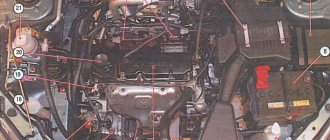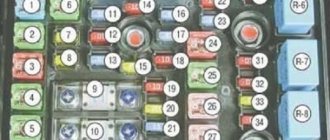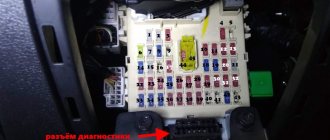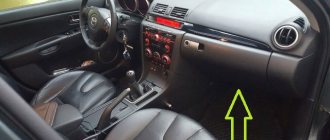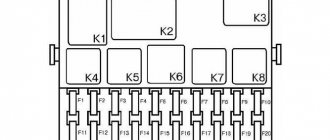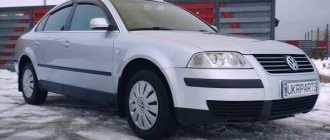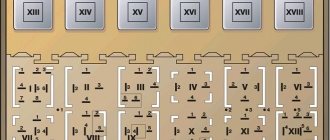The Nissan Almera has been produced since 1995. During this time, it has undergone many changes, both external and related to the production process. Initially, the car was manufactured in Japan and was produced on the platform of such models as the Nissan Pulsar and Nissan Bluebird Sylphy. Later the car began to be produced in other countries. Today Nissan Almera is produced even at AvtoVAZ. But I will not talk about the history of the model, but about its technical features related to the electrical equipment of the machine. In this article we will talk about fuses and relays for Nissan Almera for the N16 body (second generation Almera 2000-2006) and for Almera G15 (2013-2020).
Block in the car interior
It is located in the instrument panel on the left side, behind the glove box.
Photo
Back and front side
Scheme
Description
Circuit breakers
- 10A Mirrors
- 10A Brake Light Bulbs
- 15A Electrical socket
- 7.5A For additional electrics
- 15A Hazard alarm and turn signals
- 10A For additional electrics
- 20A Heated rear window
- 10A Oxygen sensor
- 10A Additional electrical package
- 10A Electrical package
- 10A Automatic transmission controller
- 10A ECU (i.e. all control of all turn signals, backlight and main power supply of the dashboard, backlight of the panel where the stove is)
- 10A Interior lamp
- 15A Interior fan electric motor (heater/air conditioner)
- 10A Air conditioner
- 15A Interior fan electric motor (heater/air conditioner
- 10A Fuel injection system
- 10A Airbags
- 20A Additional electrical package
- 10A Motor Controller
- 10A Start signal
- 15A Cigarette lighter
- Not used
- 20A Additional electrical package
- 20A Windshield wiper
- 7.5A For additional electrics
- 15A Front and/or rear window washer (on the steering column switch)
- 15A Rear window washer
- 15A Fuel pump
- 10A Speedometer, tachometer, temperature and fuel level indicators
- 10A ABS
- 10A Reserve
- 15A Reserve
- 20A Reserve
Fuse number 22 at 15A is responsible for the cigarette lighter.
Face Relay
- R1 Headlight relay
- R2 Throttle control relay
- R3 Power window relay
- R4 Rear fog lamp relay
Rear side relay
- R1 Ignition relay
- R2 Blower motor relay
- R3 Relay for additional equipment (electrical accessories)
In what cases is it necessary to replace the windshield wiper blade for a Nissan Almera Classic?
To understand that parts of the system already need to be replaced, a timely, careful inspection will be enough. It is important to pay attention to the following points:
- Presence of cracks. This again occurs for temporary reasons when the material becomes stiff over time. The weather in hot climates has such “abilities”. When elasticity is lost, it's time for replacement.
- Stains on the windshield. Because of this, visibility deteriorates, which is especially dangerous in rainy times.
In some cases, the reason must be sought in another source. It will not be necessary to replace it, but to work on a different plan if:
- The movements of the brushes themselves resemble an epileptic seizure (and it can all start with a simple twitch). Here the possible problem is hidden in the electrical component of the system. There are clearly two possible reasons here - the wire coming from the switch under the steering wheel or the contacts on the trapezoid gearbox have come loose.
- The wipers start working only in super-fast or normal mode (intermittent is excluded).
- “Sticking” of the lever for turning on the liquid splashing on the glass. The mode does not turn off even by disabling the “on the go” mode.
- The part stops working intermittently during rain.
All of the above aspects point to one thing - it’s time to get acquainted with the electronic content of the switch. This is where some knowledge in this area will come in handy.
Fuses and relays under the hood
Fuse box
Located next to the battery. A current diagram with a description will be printed on the cover.
Scheme
Purpose
- A 100A Generator (charging to battery)
- 40A electric windows
- With 40A cooling fan controller
- D 40A cooling fan controller
- E 30A for diesel engines
- F 60A for diesel engines
- G 80A for diesel engines
- H 80A main power supply, ground circuit
- I 50A ABS
- J 30A to battery ignition switch
- K 30A ABS/ESP
- L 30A ESP
- M 30A Headlight washer
- 32 20A Rear window washer
- 33 15A Fog lights
- 34 15A Electric drive and electric throttle relay
- 35 15A Headlights, daytime low beam system
- 36 15A Headlights, daytime low beam system
- 37 10A Rear fog lamp
- 38 10A Dimensions, license plate lighting
- 39 10A Klaxon, battery charging (excitation current to the generator from the battery)
- 40 15A Audio, navigation, LCD display
- 41 10A Engine control system
- 42 10A Ignition coil
- 43 10A USR
- 44 20A Engine ECU
Relay block
It is located near the right wing, on the side of the washer fluid barrel.
Photo diagram
Decoding
- R1 3rd radiator fan relay (25221E)
- R2 Front fog lights PTF (25224QA)
- R3 Air conditioning relay E6 (25224D)
- R4 Horn relay (25620)
- R5 Radiator fan relay (25224J)
- R6 Headlights, light (25224A)
- R7 Starter (25224G)
The information doesn't fit? Select the option you need from the full description of all models.
What does a windshield wiper on a Nissan Almera Classic consist of?
The design is simple. It has three components:
- fastening unit;
- pressing block;
- Nissan Almera windshield wiper blades.
The first point refers to a special removable type mechanism. It includes a pin with fasteners. The parts are attached to each other with a special adapter - each manufacturer has its own, but it determines how reliable the design as a whole is. In another way it is called a trapezoid.
The principle of operation of a trapezoid is a lever - after turning at one end, the brush will make the specified movements at the other (either left or right). The frequency is also adjustable - for this there is a switch located on the steering column. This mechanism is driven by an electric motor.
The clamping block is an arc system in which the parts are connected to each other. Their number is different (depending on the size of the Nissan Almera classic wiper blades). Arcs are made of both metal and plastic (in the first case, plastic or rubber inserts are required to prevent dirt and dust from getting into the element).
The Almera Classic windshield wiper blades themselves are made of rubber. This is suitable for removing dirt and moisture from glass. During manufacturing, strict requirements are met: such elements are flexible and rigid at the same time.
It is important to focus on the size of the Nissan Almera N16 wiper blades.
More about Nissan: Suspension - Eats rubber on the outside on one front right wheel | SUZUKI CLUB RUSSIA
The length indicators for standard (factory) wipers are as follows:
- the driver's wiper blade for the Nissan Almera Classic is 55 cm;
- for the passenger wiper blade of the Nissan Almera N16 it can be equal to 41 cm (it cannot be installed longer than this option).
Where is it located?
Two relays are responsible for the operation of the starter; it is important not to confuse them. One is located in the engine compartment and is responsible for starting the equipment.
The second is located directly on the starter, also called the retractor. During repairs, it must be removed (all work is carried out only after dismantling the starter).
How to repair a trapezoid
Slowly operating windshield wipers indicate that defects are “waiting” in the trapezoid. For example, if the trapezoid of the Nissan Almera Tino windshield wiper is not lubricated in time, then this definitely threatens to break. There is nothing difficult about repairing this part.
To begin, prepare the tools. These include:
- key to 14;
- crosshead screwdriver;
- head at 10.
In order not to cause harm by your actions, it is suggested that you strictly follow the instructions. The recommendations will be:
- The plastic caps are removed from the windshield wiper arms.
- Use a wrench to unscrew the fastening nuts.
- The lifts themselves must be removed very carefully (preferably using a special puller).
- After this, use a Phillips screwdriver to remove the clips on both sides. Let's take them out.
- Also remove the pads from both sides (simply by pulling up). Then you can easily disconnect the tube through which the windshield washer fluid is supplied.
- Remove the staples (there are 5 of them) by spreading the tabs and pulling them up.
- Now the plastic trough can be pulled out and you can see the trapezoid itself along with the engine.
- Unscrew all three bolts with a head.
- Disconnect the terminal from the electric motor.
- The structure can be easily obtained.
You can carefully examine the trapezoid. Is it noticeable that the levers are connected to each other by hinges? The only caveat is that they are usually plastic. This leads to the fact that such material wears off and will no longer snap onto the metal pin.
The problem with this part is dirty axles. You can carefully unscrew them and clean off the oxides and corrosion that prevent the wipers from rotating normally. This is done as follows:
- Pulling to the side, remove the locking cap - under it there are two thin washers and a rubber ring
- Parts are thoroughly cleaned.
- It is recommended to apply CV joint lubricant.
- Reassemble in reverse order.
This procedure is required if you suspect slow operation of the windshield wipers. Otherwise, the motor will burn out, and this is already fraught with financial investments.
We recommend looking for additional information here.
Do-it-yourself repair of direction indicators and hazard alarms
If the turns disappear, as well as the car’s emergency signal, then you can try to solve this problem yourself:
- If the safety element and relay break down, the failed parts must be replaced. If the reason lies in a short circuit, then before replacing it is necessary to check all electrical circuits in which it could occur. Only after the cause of the short circuit and power surges has been eliminated, the devices need to be changed.
- If the hazard warning button is faulty, you just need to replace it. We have already talked about how to diagnose this part.
- As for electrical circuit diagnostics, it is carried out using a tester. If damaged sections of the wire are identified, they must be replaced. When laying them, make sure that the wiring does not come into contact with moving body elements. It is also recommended to additionally insulate new wires to increase the reliability of the insulation.
- If the reason is the light bulbs, then all burnt out light sources must be replaced. In the front and rear headlights, the lamps are changed by removing the protection from the headlights, disconnecting the power circuit from the lamp, as well as unscrewing the light source from the seat and replacing it with a new one. If the lamps in the side headlights do not work, then, as a rule, to dismantle the lighting sources, the lamp itself must be pryed off with a screwdriver, then disconnect the power cord and remove the device.
- If the reason lies in the steering column switch, then this device needs to be disassembled and checked. As a rule, the cause of switch failure is poor contact or abrasion. In this case, the failed switch is replaced with a new one. As for the contacts (no matter where - on connections or buttons), it is advisable to clean them.
- You should also check all the plugs and connectors, because it is quite possible that the problem is poor contact on them. Acidified contacts must be cleaned with a wire brush or sandpaper. If the contacts are burnt out, they will need to be replaced.
Turn switch
Another, no less important, element of the turn signal system is the switch on the steering column. It is usually reliable, but given the frequency of its activation, especially in urban traffic, it often fails.
In order to replace it, you need to remove the plastic steering column protection cover. The switch is usually secured with latches, sometimes with screws. Dismantling is not difficult.
Some craftsmen undertake to repair them. It’s better to change it right away, maybe for a used one, if there is no other option.
Turns relay
Until recently, the main element of turn signal and hazard signal systems was the turn relay. In the middle of the last century, turn relays with a bimetallic plate were used. In some models of budget cars and trucks they are still used to this day. Along with simplicity and low cost, they are more reliable and maintainable. A typical relay circuit is shown in the figure:
The core of the circuit is a bimetallic strip. It is included in the circuit of current flow through the turn lamps. When turning on the turns or emergency lights, it is in a non-heated state, and closes the circuit of the warning lights, they turn on. As the bimetallic plate is heated by the flowing current, it changes its geometric dimensions (bends).
A little physics: a bimetallic plate consists of two (bi) bonded plates with different coefficients of thermal expansion. When both plates are heated, one expands more, the other less, hence the deformation. When bending, the plate opens the relay contact, the current stops flowing, the lamps go out, the plate cools down again, the contacts close, the lamps light up, the plate heats up... So ad infinitum. If one of the lamps burns out, the current will be less, the plate will heat up more slowly, and the blinking period will increase. If there is a short circuit in the circuit, the lamps will flash quickly. Everything is very simple, reliable and informative. Such relays have been used for more than half a century.
Nowadays, combined relays with a built-in electronic circuit are used.
Such circuits are less reliable and often fail, especially from unknown manufacturers. Relays are usually mounted either on the steering column or in the fuse box under the dash. This is done so that their operation can be heard by the driver. In modern cars, there is an additional buzzer in the dashboard that duplicates the turn indicators. Such relays cannot be repaired; they must be replaced.
Video - what to do if the turn signals and emergency lights of the VAZ 2114 do not work:
Faulty wiring, lamellas, lamps
Detecting the location of electrical wiring damage is difficult because the system serves the rear parking lights. The wires to them go through the interior; often the lamps are located on the trunk door. The most common places for electrical wiring damage are:
- under the thresholds, especially the driver's and front passenger's;
- in the corrugated adapter for wiring to the trunk lid;
- in the connector of headlights and lamps.
If one of the light bulbs does not light, first of all you need to ring it; if it is working, tighten the slats and contacts of the socket into which the light bulb is inserted.
Modern cars often use LED emitters. Despite the high reliability of LEDs individually, emitters as part of an LED line often fail. It is better to contact specialists for repairs. You can solve the problem yourself by replacing the faulty diode in the line. Its power is usually in the range from 0.2 to 1.0 watts.
Hazard switch
If this part breaks, the lamps start on both sides simultaneously. On some cars, the rotary control relay is located in the hazard warning light switch. A new button is inexpensive, so it is recommended not to repair it, but to replace it.
Malfunction or software failure of the body control unit
In some models, such as the Lada Priora, the functions of switching the indicators in question are transferred to the body control unit. The advantage is the possibility of centralized control, the disadvantage is the complication of auto repair. To eliminate the breakdown, disassembling the unit is required. Such repairs are performed only in a car service center.
Blown fuses
Fusible parts responsible for the operation of turning or emergency lights rarely burn out. If this does happen, check the integrity of the wiring, the condition of the lamp contacts, and replace the fuse if necessary.
The second generation Nissan Almera has the N16 body marking and was produced in 2000, 2001, 2002, 2003, 2004, 2005 and 2006 with hatchback and sedan bodies. Restyling in 2003 affected mainly the appearance of this car. In our publication you will find information describing the fuse and relay blocks of the Nissan Almera N16, their location and purpose.
p, blockquote 1,0,0,0,0 —>
p, blockquote 2,0,0,0,0 —>
Other turn signal malfunctions
As for other problems, in addition to the relay, we can highlight: burnout of lamps, both main and turn signal indicators, malfunction of LED “strips,” malfunction of the turn switch on the steering column, malfunction of indicator lamps on the instrument panel, problems with the hazard warning switch, exit from building control blocks, etc.
The main symptoms that allow you to localize the malfunction:
If we look at the light bulbs and wiring, difficulties may arise with the fact that this system on many cars is also responsible for the side lights. This means that the wiring is routed throughout the cabin, and the lamps are on the trunk lid.
We also recommend reading the article about what an immobilizer is. From this article you will learn what functions an immobilizer performs on a car, what advantages this solution has, and also what type of immobilizer is better to choose.
In fact, you need to look at the wires under the sills, as well as where the wiring passes from the body to the trunk lid. It is also necessary to inspect the wiring in the headlight connectors. Usually, if one lamp does not light, it is necessary to “ring” the lamp and check the contacts. If there are diodes on the car, it is better to change them immediately.
We also add that the hazard warning switch may also require special attention. It often happens that when you turn on a left or right turn, all the lamps flash at once. The cause may be either a faulty turn switch on the steering column or the hazard warning switch.
Also in the list of problems, when the turn signals do not light up, a failure of the control unit is noted. This unit is installed on modern cars of certain brands.
You can also highlight the blown fuses of the turn signal and hazard warning system. In this case, it may seem that replacing the fuse is sufficient. In fact, fuses rarely blow without reason, which means in-depth diagnostics are still necessary. Otherwise, the turn signals may fail again at the most inopportune moment.
Nissan Almera windshield wiper relay: dealing with mode switching violations
The Nissan Almera windshield wiper relay is indeed “responsible” for problems with mode switching. It is a simple electrical circuit through which the Nissan Almera windshield wiper motor works.
Problems can be solved as follows:
- A switch that has become detached from the steering column can be welded into place using simple soldering.
- If the contacts on the gearbox have moved away from the trapezoid, then it will need to be removed. To do this, the negative terminal is disconnected, then the leads on the wipers are removed, the frill is separated and you can already remove the trapezoid. It is on this that the Nissan Almera windshield wiper motor and gearbox are located. It is enough to remove the cover, which is held on by three bolts, and the problem becomes obvious - perhaps one of the three copper legs has bent (all that remains is to straighten it and carefully, trying not to touch the contacts with lubricant, put everything back together in the reverse order).
- In the case when the wipers work constantly when the ignition is on, operate untimely and other similar moments, you need to “sin” the control chip responsible for the intermittent operation. It also turns on the windshield wipers when the washer is turned on. For both the front and rear windows, the Nissan Almera windshield wiper motor starts precisely from this circuit. The wiper is turned on when the connector is wet. In this case, both terminals for the wipers must be pulled to 12 using 1 kOhm resistors.
- Problems can also arise when the contacts in the Nissan Almera N16 windshield wiper relay have melted. In this case, it will be closed with a blackened resistance (and in the gearbox, on the contrary, all contacts are closed).
More about Nissan: Types of electric motor faults
Nissan Almera classic wiper blades: replacement rules
Nissan Almera windshield wiper blades are made of rubber - this material wears out quickly. This is logical after months of work to remove vision-obscuring deposits from the windshield. Replacing a windshield wiper blade on a Nissan Almera Classic is such an easy process that it would be a sin not to try to do it yourself.
Moreover, the instructions for the event are simple:
- You should find out which part of the system needs to be replaced. The wipers themselves consist of a lower arm (it extends from the bottom of the windshield), a metal blade and a rubber blade. If we are talking about poor cleaning, sometimes the “gum” itself is changed.
- Exact dimensions are taken from old blades - measurements will help you purchase exact analogues. The size of the Nissan Almera Classic windshield wiper blades is not the same for the left and right versions (one of them will be shorter than the other).
- To install new wipers, lift the metal lever. It must be fixed straight and perpendicular to the windshield. It is important to be careful here - make sure that the lever does not fall off the spring (in this case it could damage the windshield).
- How to detach the old wiper blades on a Nissan Almera n16? It is secured with a small plastic clip. It is enough to press it lightly to release the brush from the handle. Sometimes the latch acts as a hook. Now it will be quite easy to pull out the faulty part.
- New windshield wiper blades on a Nissan Almera are easily inserted in the reverse order. Simply insert the part into the clamp and wait for the characteristic click.
Are there any recommendations for purchasing new parts? Experienced fans of this brand recommend purchasing Finnish windshield wiper blades for Nissan Almera g15 as the best and highest quality in their category.
What can cause the emergency lights to fail?
In most cases, the emergency lights stop working due to:
• There are faults with the LED strips.
• Failure of rotary relays.
• There are faults with the switch, which is located on the steering column.
• Damage to electronic components of the system.
• The presence of malfunctions with indicator lamps that are located on the dashboard of the car.
To independently find and eliminate the cause of the problem, you need to familiarize yourself with each malfunction.


